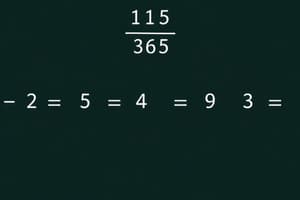Podcast
Questions and Answers
What defines a proper fraction on the number line?
What defines a proper fraction on the number line?
- It can be negative.
- It always exists between zero and one. (correct)
- It represents a whole number.
- It is larger than one.
What is the result of adding 12/8 and 9/8?
What is the result of adding 12/8 and 9/8?
- 21/8 (correct)
- 3
- 12/16
- 24/8
Which of the following correctly describes an improper fraction?
Which of the following correctly describes an improper fraction?
- Includes only whole numbers.
- Always less than one.
- Cannot have a negative numerator.
- Can be represented by a mixed number. (correct)
Which statement about rational numbers is NOT true?
Which statement about rational numbers is NOT true?
What is the product of 12/5 and 3/13?
What is the product of 12/5 and 3/13?
What term describes two rational numbers that are equidistant from zero on opposite sides?
What term describes two rational numbers that are equidistant from zero on opposite sides?
How is interest calculated according to the formula that is typically used?
How is interest calculated according to the formula that is typically used?
What process involves multiplying a number by itself three times?
What process involves multiplying a number by itself three times?
Flashcards are hidden until you start studying
Study Notes
Rational Numbers
- Proper fractions always exist between zero and one on the number line.
- Improper fractions are represented on the number line by first converting them into mixed fractions and then representing them on the number line.
- Two rational numbers are considered opposites if they have the same distance from 0, but on different sides of 0.
- Two rational numbers with the same denominator are compared by comparing their numerators. The number with the greater numerator is greater.
- The sum of two fractions with the same denominator is calculated by adding their numerators and keeping the same denominator.
- The product of two fractions is calculated by multiplying their numerators and multiplying their denominators.
Interest
- The money that is borrowed or loaned is called the base (B).
- The interest paid on the original principal during the whole interest periods is called compound interest.
Squaring and Cubing Numbers
- Squaring a number is the process of multiplying a number by itself.
- Cubing a number is the process of multiplying a number by itself three times.
Square Roots and Cube Roots
- The square of 12 is 144.
- The square root of 121 is 11.
- 8 is the square root of 64.
- 216 is a perfect cube of 6.
- The cube root of 512 is 8.
Studying That Suits You
Use AI to generate personalized quizzes and flashcards to suit your learning preferences.




